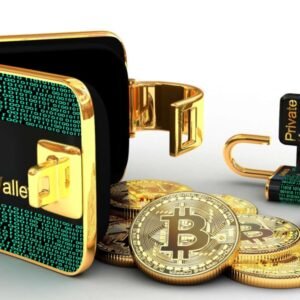Digital artworks produced by algorithms and issued as distinct tokens on the blockchain are known as generative art NFTs.
Comprehending NFTs in Generative Art
With the use of autonomous systems, generative art produces original works of art by according to predetermined guidelines or directives. These works of art are produced and then minted as nonfungible tokens (NFTs) on a blockchain, which offers a safe and authentic record of who owns what.
The advent of generative art in the digital era signifies a noteworthy transformation in the production and dissemination of artistic works. These days, artists use complex computational procedures and computer languages, including Python, Processing, and p5.js, to create works of art that can change over time or react to different external stimuli. The incorporation of elements of unpredictability, complexity, and interactivity into the process of creating art pushes the boundaries of traditional art, producing generative art that is genuinely unique and allows for an infinite range of outcomes.
The process of authenticating, owning, and trading digital artworks has been completely transformed by the integration of NFTs with the art. For both artists and collectors, the use of blockchain technology to mint NFTs offers a new approach to monetizing digital works of art and investing in digital art, which has important ramifications. Blockchain’s transparent and secure features guarantee the provenance of every item, offering a degree of authenticity and scarcity that was previously challenging to attain in the digital sphere.
How are NFTs of Generative Art Made?
Generative art is created by artists using algorithms, and it is subsequently created as a distinct NFT on the blockchain.
Art that is generated NFTs are the result of a symbiotic partnership between technology and art, in which computer algorithms act as a middleman in the creative process. Programming languages are used by artists to create computer programs or define sets of guidelines. The generation of the artwork’s shapes, colors, patterns, and movements is governed by these laws.
Furthermore, generative art NFTs create dynamic, one-of-a-kind artworks mostly through imaginative coding. This permits preliminary alterations and the possibility of art changing over time in response to user engagement or other factors. In order to guarantee that every NFT is distinct, they also include elements of randomization. Additionally, they include guidelines to ensure that the overall aesthetic is in line with their vision. Some well-liked creative coding tools are Max/MSP, NodeBox, and openFrameworks.
The last step in turning the digital artwork into a distinct asset on the blockchain is to mint it as an NFT. Through the creation of a tamper-proof digital certificate of ownership, the minting process guarantees the validity and scarcity of the artwork.
The NFT is bought by a collector, who then sets off the smart contract to run the generative code on-chain. The code creates a completely unique, one-of-a-kind rendition of the artwork just for that collector by using randomness based on variables like transaction details or block data.
What Makes NFTs of Generative Art Special?
The creation method of generative art NFTs is algorithm-driven, guaranteeing that every piece is genuinely unique and dynamic.
The dynamic procedures that go into creating generative art NFTs and their inherent distinctiveness make them stand out. Every piece is the outcome of a sophisticated interaction between algorithms, parameters set by the artist, and occasionally random components or real-time data inputs. This guarantees that, even with the same set of guidelines, the results can differ greatly, producing really unique pieces of art.
Artistic digital scarcity
Blockchain technology has made a fundamental idea tangible: digital scarcity. In the domain of art, it refers to the capacity to demonstrate the uniqueness, ownership, and restricted existence of digital goods in a setting where digital duplication is commonplace and easy. This idea is used by generative art NFTs, which use blockchain technology to verify and document the ownership and uniqueness of each piece of art.
Tokenized Artwork
Art becomes a distinct identity when it is tokenized and recorded as NFTs on the blockchain thanks to its metadata, which contains details about the author, the date of creation, and ownership history. The authenticity and provenance of the artwork are guaranteed to be preserved permanently because this metadata cannot be changed. This tokenization method is essential for generative art since it protects the specific settings and conditions under which the artwork was created, as well as certifying each piece’s originality.
Where can one find NFTs of generative art?
NFTs for generative art can be found on a range of internet platforms, from large marketplaces to specialized websites devoted to generative art.
Blockchain technology and digital art are served by a number of internet platforms that make generative art NFTs available. These platforms include specialized websites devoted to generative and algorithmic art as well as large NFT marketplaces.
NFT generative art marketplaces
There is a vast variety of digital art available on NFT marketplaces like OpenSea, Rarible, Nifty Gateway, and SuperRare, including NFTs for generative art. These platforms give artists a place to create, present, and market their works of art as NFTs.
Admirers can peruse vast assortments, take part in sales, and buy one-of-a-kind items straight from the artists. In order to provide transparency and insight into the provenance and worth of the artwork, these marketplaces frequently include community reviews, artist profiles, and comprehensive histories of each item, including past ownership and sale prices.
NFT platforms for creating art
Apart from generic NFT markets, there are platforms dedicated to generative art and its distinct production process. One prominent example is Art Blocks, which provides a curated area for artists to use their generative algorithms.
A unique instance of the artist’s work is created by the Art Blocks platform’s algorithm upon the collector’s purchase of a piece, and it is subsequently minted as an NFT on the Ethereum blockchain. This guarantees the individuality of every work and establishes a clear connection between the act of creation and collection.
Problems Using NFTs for Generative Art
Challenges in the cutting edge field of generative art NFTs include those related to intellectual property, authenticity verification, and ethical dilemmas.
It can be particularly difficult to navigate intellectual property laws in the context of generative and digital art. Since algorithms designed by artists create generative art, it becomes unclear who is entitled to copyright: the artist, the algorithm, or the ultimate user who manipulates the art to produce a finished work. The distribution and sale of digital artworks can become more difficult as a result of this uncertainty, which may give rise to ownership disputes and copyright violations.
Although NFTs by design offer a way to confirm the provenance and validity of digital artworks, the technique is not infallible. It might be difficult to verify that customers are getting authentic and original artwork when dealing with fake NFTs, which occur when someone mint artworks without the original artist’s consent. Although a benefit, blockchain technology’s decentralized structure can also make regulation and monitoring more difficult.
Additionally, there are ethical concerns in the generative art NFT domain, namely with regard to the transparency of the art production process and the possibility of algorithms copying or deriving from preexisting works of art without permission or acknowledgment. Further ethical concerns concerning the originality, authenticity, and respect for others’ intellectual property rights are brought up by the use of data and AI in the creation of art. These moral issues demand constant discussion and the creation of best practices within the community.






